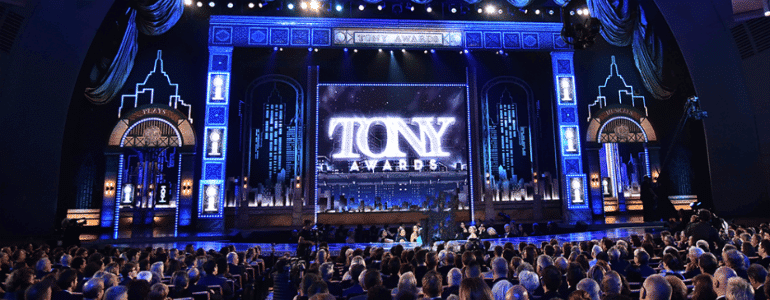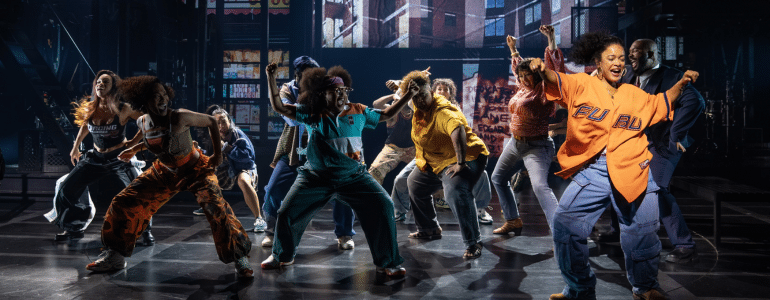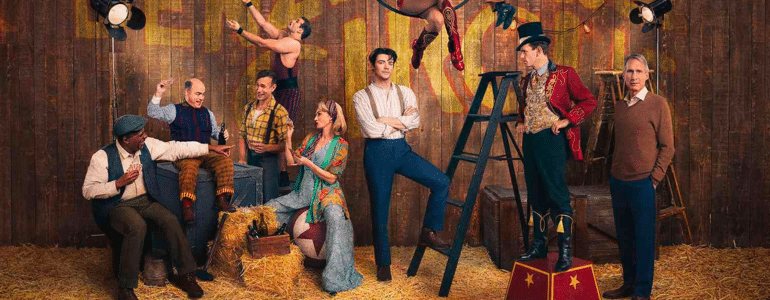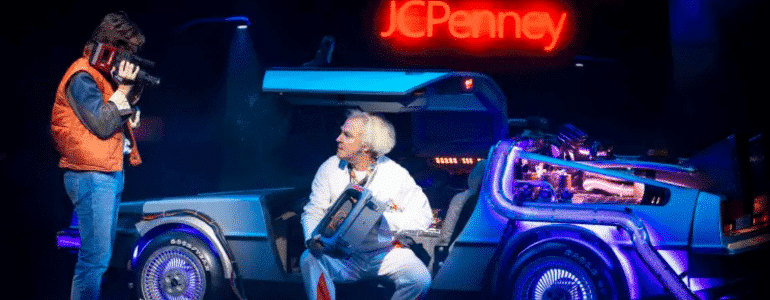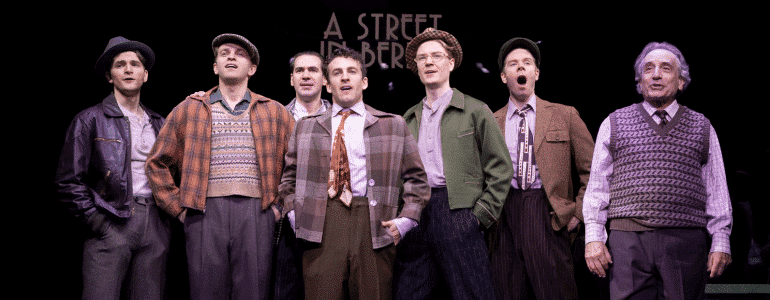Transcript – How to Make Broadway More Accessible: Keynote Address by Timothy Shriver
Ken Davenport: Please join me in welcoming Mr. Timothy Shriver. (Applause)
Timothy Shriver: Thank you, Ken. Let me echo his thanks for all of you for coming today on a Friday afternoon and for being willing to engage this topic. A special shout out to Ken and this entire company. My wife and two daughters were here last night. They’re here, my daughters Caroline and Kathleen, and my wife Linda. (Applause) They almost never do it. It took a Broadway show for me to get them to come and listen to me speak. It was an extraordinary treat. I will say it was a slightly unusual one. We came last night as part of my wife’s birthday, her 60th birthday. I did not expect to be sitting in the audience watching large numbers of teenagers masturbate frequently. (Laughter) I’m just saying, it was an unusual experience. Then when my 18 year old daughter was fidgeting nervously in her chair during one of the scenes and reaches over to me and says, “Dad, did they really just do it?” I of course said, “No, Caroline, they did not just do it.” She’s like, “Dad, I saw his ass. I think they did it.” Okay, thank you, Ken! (Laughter) I know. That’s not what I’m here to talk about.
I am excited though. I’m not in the arts, per se. And I don’t know Broadway well except as a fan. But I thought for me, last night was a turning point, an opportunity to connect in a much more profound way, not with disability rights. Ken just said in his introduction the goal is to make Broadway more accessible. On some level, I think that’s maybe step one. Step two is to make better art. To make art more honest, more authentic. I come from the field of intellectual disability. People with cognitive challenges. A field that used to be known by language like “idiot” or “imbecile,” “moron,” “retard.” Those are all actually technical terms to describe, those are not playground taunts, at least not initially. Those were scientific terms to describe people with intellectual or learning challenges. The field that we have built on behalf of, or in some sense from those people around the world, the field of Special Olympics, is not so much a movement for them as it is a movement from them. I felt like last night watching the show was not so much a play for people with hearing or speech or ambulatory challenges, but it was art from them, to those of us lucky enough to see it. It is no longer, in my view, enough to say we are in a disability rights movement, in an accommodation movement, in a movement trying to adapt people with differences to the norms of the world. We are really much more now in what I call a “dignity revolution,” where the goal is to challenge people to rethink their most fundamental assumptions who about matters and how we determine who matters, and most painfully how to end the exclusion of those whose mattering is lost or somehow blinded to us.
My movement is a sports movement. You might ask, “Why sports? How can sports carry a revolution?” In some ways it’s very much like art. Sports takes us out of our heads a little bit. Right? We play not so much with our words or with our concepts as with our bodies. We play not so much with facts as with imagination. We play not so much to analyze or understand the world as it is as much as it is to create relationships driven by joy, or competition, or by connection or engagement, by the use of our bodies to achieve some goal, usually together. In my view, very much like art, powerful carriers of revolutionary changes in the way in which we see one another.
People with intellectual disabilities have struggled much like people with hearing challenges and speech and mobility challenges for a long time. I don’t think we should under estimate the revolutionary nature of the change that was on stage here last night and has been for several months. In our world people with intellectual challenges . . . this play was set in the 1890s. That was the period in which the play invites us to see an opening, a challenge to establish morals, a way of seeing morality differently. For people with intellectual disabilities, it was the beginning of the ascendance of exclusion and separation. It was the beginning of the scaling of the institutional model. The idea that people who had intellectual challenges were so different that they could not exist, could not live, could not be tolerated in society. They must be put behind walls and removed from our lives. I had an aunt Rosemary who was born in 1918. She was born nine years before the Supreme Court’s decision in 1927 that legalized the forced sterilization of people with intellectual disabilities on the grounds that they were carriers of bad seed. The cultural pattern that we are challenging, the pattern that sees vulnerability, dependence, and difference as pathology, as risk, as threat, is deep. It’s a very deep pattern. My aunt Rosemary Kennedy lived a long life, but it was a difficult one, and one in which amongst her siblings she was the challenged one, the one who was hidden, the one who ultimately was the victim of a medical experiment that dramatically changed and limited her life. But the one whose vulnerability, if you can say this, ultimately led to the revolution. The one whose big open heart, the one who didn’t have to earn herself merit and value the same way her brothers and sisters did, that person is arguably, in my view at least, the person who was most responsible for triggering a revolution in the way in which people with intellectual disabilities were treated.
My favorite story from the world of Special Olympics came some years ago at one of our larger events, an opening ceremony not too far from here at Yale Bowl in Connecticut. In 1995 the President of the United States, Bill Clinton, agreed to come to those ceremonies. When he arrived, the security was quite poor so they kept him in the top row. Down in the field at that old stadium there were about 6,000 people with intellectual challenges, and they’d all been given single use cameras. Some of you are old enough to remember cameras. (Laughter) They had their cameras out in the field and a professional photographer was taking pictures. He noticed that a group of the athletes were trying to get a picture of the President. Imagine him, ten times higher than the back row here. The athletes were all holding up, as the President was speaking on the Jumbotron, their cameras to get a picture. The professional photographer looked closely and noticed they had no idea how to use a camera, because the lenses were all backwards. They were on their noses. He concluded they were from an African nation and had never used a camera before. He went over to say to them, not knowing if they spoke English, “You’re trying to get a picture of the President way up there,” and the athletes gestured. “You have to turn the camera around and push the button. You look through this hole and you’ll get a good picture.” The athletes said, “Oh, thank you. But if you look through the view finder backwards it works like binoculars and you can see the President perfectly clearly. Thank you very much.” (Laughter)
(Laughter) I just wanted to make sure everybody got the joke.
The reason I love the story is because it reminds me at least of how often we get each other wrong. Photographer was a good guy. Generous, open hearted, there to help. But he looked at another group of human beings, and he saw a disability. He saw limitation. He assumed incompetence. And how often do each of us look at each other and make those same mistakes? How often do you look at someone in a wheelchair or someone signing, or someone in your own family your brother, your sister, your mother, your father how often do we look at each other and not see clearly the giftedness? Not see the possibility that that person sitting across the kitchen table from you has a heart bursting with gifts, desire, hopefulness, the capacity to give. And we see something, some distraction, some label, some way of categorizing that other person that immediately renders them less, that immediately assumes the incapacity to belong.
It is that assumption we even see this in the Biblical literature. Moses, one of the great figures said, “Not me. I stutter. I can’t do this. I have poor speech.” But something awakened in him that said, “Yes, me. I can do it. I have the gift. I can trust that I can contribute.” The fear of difference runs deep. People with disabilities are three, sometimes four times more likely to be bullied in schools today. People who come from different racial backgrounds, ethnicities, all you have to do is watch the news, whether it’s in Ferguson, Chicago, Baltimore. Our long national nightmare continues. Just when we think we’ve overcome, that we all think we’re completely open and tolerant and liberal and live in New York, we’re reminded how hard it is to really see one another clearly. And yet art Christian Weinman says art puts the soul at stake. The enemy of art, he says, is not assurance, but creative uncertainty. A creative invitation to put the soul at state and challenge. Entertaining, yes. Funny, yes. Dramatic? Yes. Even with a bare . . . butt, sometimes. I was going to use worse language, but my children are here. But art invites us to put the soul at stake.
And all I can say to you is that, as Ken said in his opening remarks, if you’re here to learn about disability because you think you ought to, you’re in the wrong place. If you’re here to learn about accommodation because you think it’s your duty or your obligation, you’re in the wrong place. Nothing great has been accomplished in social or cultural change, in my view, out of duty. What can be accomplished that is great will be accomplished out of discovery and encounter. And largely the person that needs the change is most of us who hide behind the blinders of normalcy. In our family, my wife started an inclusive sports program we call Unified Sports Program some years ago. All of our children played on this unified team and coached, Kathleen and Caroline. One of my favorite stories came when their brother Sam . . . After a practice about ten years ago, we were driving home on a February morning from a quite distant special needs school where they had just played basketball. The boys and all the girls were there, bouncing with their left hand and right hand, people shooting the wrong end of the gym, carrying the ball. If you try to play defense, many of the athletes will grab the ball and pick it up and knock you away and run down the court. I watched all this and I thought to myself, “I wonder if my kids are doing this out of obligation.” I thought the worst thing we could do as parents was force them, was guilt them into being disability rights advocates. So I asked the boys on the way home, I said, “What do you think, boys, of this Unified Sports?” The radio was blaring. They said, “It’s fine, Dad, it’s fine.” We were streaming down the highway on our way home. I said, “Seriously, what do you think?” And they said, “It’s fine, Dad. We like it.” So I turn off the radio. “Dad, what did you turn off the radio for?” “I’m asking you a serious question.” So Sam, at 12 years old, turns to me and says, “Dad, you’re so annoying.” (Laughter) He said, “Let me explain it to you like this. If you told me we were going to Disney World right now, I’d say that’s the best news you could give me. We’d go, I’d have a good time, we’d be on the roller coasters.” I have no idea what he’s talking about. Then he says, “But the only part that sucks is when you get home. Then it’s horrible. I hate it.” He said, “But when we go to Special Olympics, that’s different.” He said, “That’s kind of like the fun that lasts.” He said, “Now will you turn the radio back on? I answered your question.” In that gym, in that place of no judgment, in that spot where the score wasn’t being kept, that 12 year old boy and his brother and sisters learned something that I hadn’t actually understood, that there’s a difference between the fun that’s temporary and fun that lasts.
That there is a possibility encounter and in relationship, and in intimacy, if you will, that one doesn’t have to have an expiration date on. This is a generation, the younger centennials and pesky whipper-snappers, who are demanding those kinds of encounters. If there is one issue that pesky whipper-snappers say is most important to them, if you ask them “Has my life been made better by being around different people?” over 80% say yes. Same is true of centennials. Am I looking for different cultural experiences? 75% of children under 19 and 73% under 35 say yes. So we are riding the cusp not just of an opportunity but of a demand. It will not be realistic for people to attend Broadway theater in 20 years from now and not assume that the full range of human diversity will be on stage. I do not believe that theatergoers or anybody else will allow that to happen. They will expect creative uncertainty.
Last night’s play spoke of so many things. Not of moralizing. Moralizing is wrong. Not of conformity. As a friend of mine said, conformity is making yourself less interesting than you are. Last night challenged conformity. It wasn’t about ego. Ego is about protection. There was huge risk on stage last night. It wasn’t even, Caroline and Kathleen, about pleasure, notwithstanding that there was some evident. But if pleasure is defined as no pain, as removing vulnerability from life, as getting rid of things that challenge you, that take you out of your comfort zone, then last night wasn’t about any of that. Last night was, for us, for me, an encounter with a different form of sacred. Maybe not the religious kind that was parodied on stage, but a new kind that’s emerging. It was best captured in my life by a scene in another Special Olympics event a few years back when I was invited to come with the President of Ireland to see what we call the motor activities show. Her office called me when we were in Dublin together to say she’d like to come to see some of the competition. I thought, “Let’s get her to the track. We have athletes running in near-Olympic times. It’ll be amazing.” She said, “No, the President would like to go to motor activities.” Motor activities is people with the most severe disabilities. People who are non-ambulatory, almost always nonverbal, have very significant challenges and do small things. I said, “No, no, no, she’d prefer-” The person said, “She’ll meet you at the motor activities at ten.” We sat in the front row. The stage was very much like this. The first athlete to come out was Domhnall Page. Domhnall, born healthy, serious brain infection at the age of two, raised by a mom and dad who were dairy farmers in the west of Ireland. With severe disabilities, with a neck brace, a wheelchair, and wheeled out in front of the audience like this. Me sitting there. His job? His athletic feat was to lift the bean bag from one side of the tray in front of him and move it to the other. The announcer says, “Off you go.” The theater was full. And he took in the room, looked around, and went about to pick up that bean bag. And as we watched him, it was clear that his arm wouldn’t go. He pushed, he moved, he smiled. But the bag was just too far away from his hand. And this went on for about a minute.
And I think you can all imagine what it’s like to sit in a room of a thousand people next to a head of state and be able to hear a pin drop, and nothing happening. And here we are all staring at this man. Until finally the arm, the shoulder starts to move and in three minutes his hand finally landed on that bag. And a few cheers came up, and a few sounds. Well, to make a long story short, it took Domhnall Page 18 minutes to slowly move that bag across in front of him. When he gets to about here, the place starts to get louder and louder. And by the time he puts the bag down on the other side, it could have been the Final Four. We’re all cheering, screaming, yelling. I’m standing, the President is standing. I have tears streaming down my face. I look over awkwardly, the President has tears streaming down her face. I thought to myself, “You know, I still got it wrong.” I didn’t want to come here. I thought the story was going to be too sad. But you’ve all seen good athletes. Cross the street and go into the sports bars. LeBron James. Good. Maybe very good. But he’s no Domhnall Page. He’s no Domhnall Page. Domhnall Page is a world class athlete. He is not a special needs athlete. He is not an intellectually disabled athlete. He is a world class athlete. Any one of you who has children would rather have your son or daughter model their lives on Domhnall Page than on any other athlete you can possibly imagine, certainly than I could. We are inviting this theatrical community not to do disability theater, but to do great art. And when we finally remove the labels, when we finally overcome our fear of difference enough to really remove the labels, we will see a flourishing of talent and creative expression, and narrative power that the world still has yet to see. Thank you again for coming today, and thank you for joining this great, what I hope will be, dignity revolution. Thank you. (Applause)
Podcasting
Ken created one of the first Broadway podcasts, recording over 250 episodes over 7 years. It features interviews with A-listers in the theater about how they “made it”, including 2 Pulitzer Prize Winners, 7 Academy Award Winners and 76 Tony Award winners. Notable guests include Pasek & Paul, Kenny Leon, Lynn Ahrens and more.







